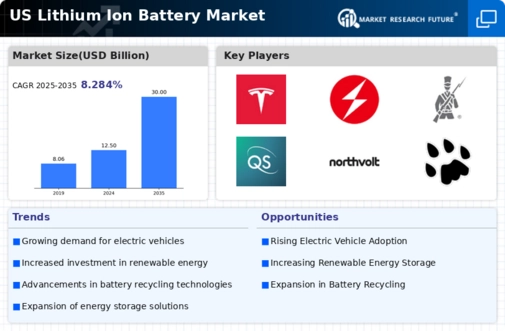Surge in Renewable Energy Adoption
The increasing shift towards renewable energy sources in the US is driving the lithium ion-battery market. As solar and wind energy become more prevalent, the need for efficient energy storage solutions rises. Lithium ion batteries are favored for their high energy density and efficiency, making them ideal for storing energy generated from renewable sources. In 2025, the US is projected to have over 300 GW of installed solar capacity, necessitating robust storage solutions. This trend indicates a growing reliance on lithium ion batteries to stabilize energy supply and demand, thereby enhancing the overall market landscape. The integration of these batteries into renewable energy systems is expected to bolster their adoption, further propelling the lithium ion-battery market.
Expansion of Consumer Electronics Market
The continuous growth of the consumer electronics sector is a key driver for the lithium ion-battery market. With the proliferation of smartphones, laptops, and wearable devices, the demand for compact and efficient batteries is surging. In 2025, the consumer electronics market in the US is expected to reach approximately $400 billion, with a substantial portion attributed to battery-powered devices. This trend suggests that the lithium ion-battery market will experience increased demand as manufacturers seek reliable power sources for their products. The integration of advanced battery technologies into consumer electronics is likely to further stimulate market growth, as consumers increasingly prioritize performance and longevity.
Government Initiatives for Sustainable Energy
Government initiatives aimed at promoting sustainable energy solutions are influencing the lithium ion-battery market. Policies that incentivize the use of clean energy and electric vehicles are creating a favorable environment for battery manufacturers. In 2025, federal and state programs are expected to allocate billions of dollars towards research and development in battery technologies. This financial support is likely to enhance the competitiveness of the lithium ion-battery market, encouraging innovation and reducing production costs. As a result, the market may witness an influx of new players and technologies, further driving growth and sustainability in the sector.
Rising Investment in Electric Mobility Solutions
Investment in electric mobility solutions is a significant driver for the lithium ion-battery market. As cities across the US implement policies to reduce carbon emissions, electric vehicles (EVs) are becoming a focal point. The US EV market is projected to grow at a CAGR of over 20% through 2025, leading to heightened demand for lithium ion batteries. This growth is supported by both private and public sector investments aimed at expanding charging infrastructure and enhancing battery technology. The lithium ion-battery market stands to gain from this trend, as the need for efficient, high-capacity batteries becomes increasingly critical to support the burgeoning electric mobility landscape.
Technological Innovations in Battery Performance
Technological advancements in battery chemistry and design are significantly impacting the lithium ion-battery market. Innovations such as solid-state batteries and improved lithium-sulfur technologies promise enhanced energy density and safety. These developments could lead to batteries with capacities exceeding 300 Wh/kg, which would be a game changer for various applications, including electric vehicles and consumer electronics. The lithium ion-battery market is likely to benefit from these innovations, as manufacturers strive to meet the growing demand for longer-lasting and more efficient batteries. Furthermore, the introduction of faster charging technologies may also enhance consumer acceptance and drive market growth.























Leave a Comment